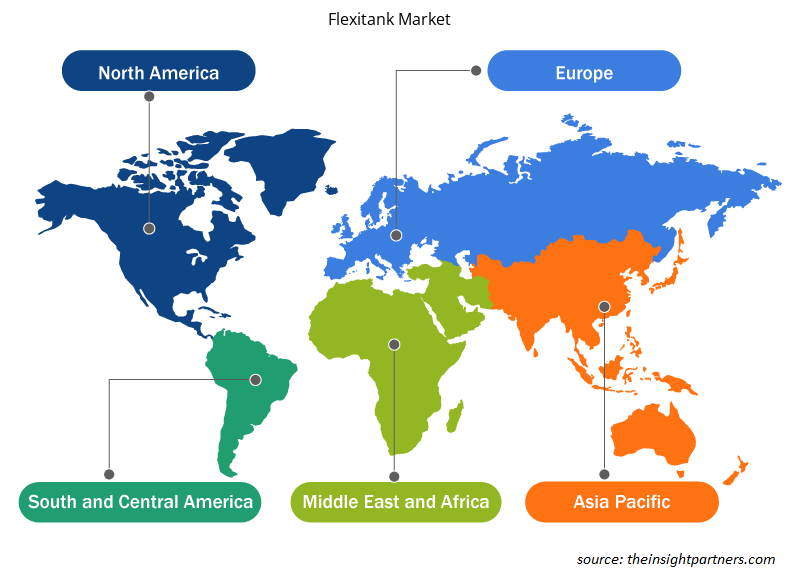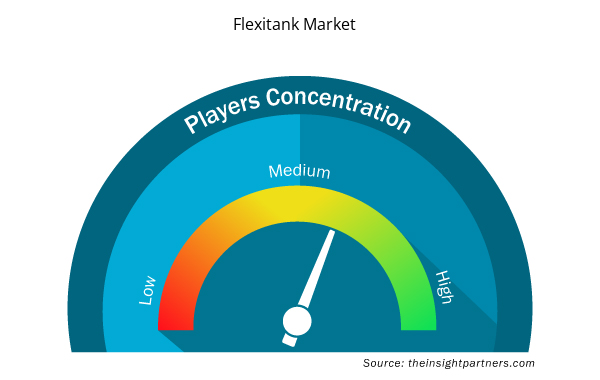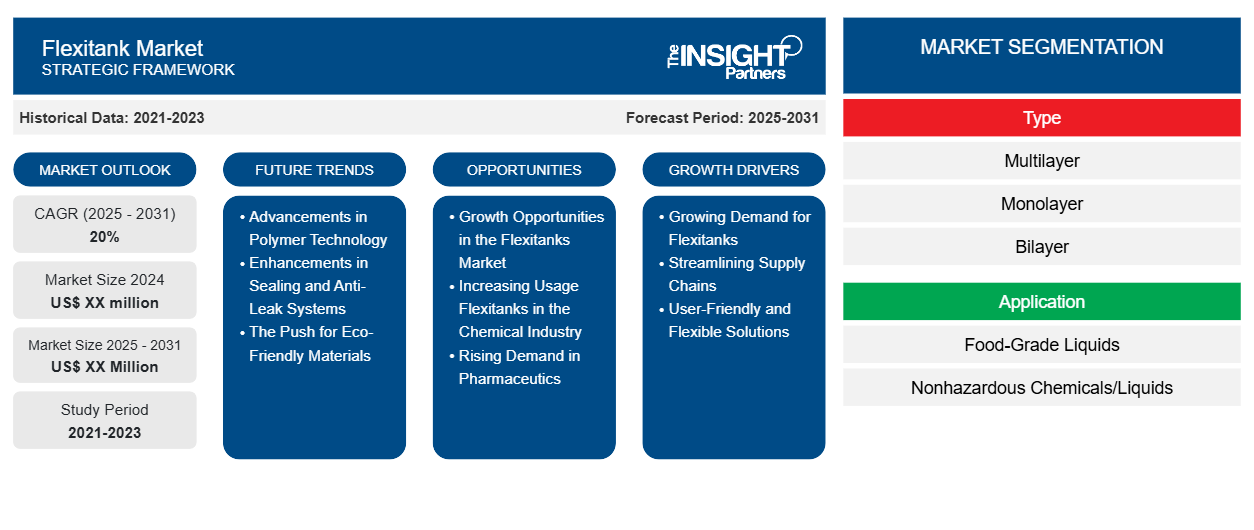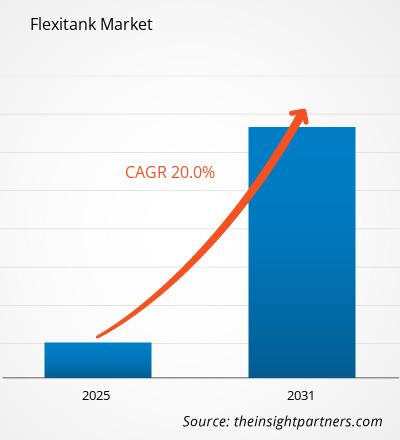من المتوقع أن يسجل سوق Flexitank معدل نمو سنوي مركب بنسبة 20٪ من عام 2024 إلى عام 2031، مع توسع حجم السوق من XX مليون دولار أمريكي في عام 2024 إلى XX مليون دولار أمريكي بحلول عام 2031.
يقدم التقرير تحليلاً يعتمد على النوع (متعدد الطبقات، أحادي الطبقة، وثنائي الطبقة). يتم تقسيم التقرير حسب التطبيق (السوائل الصالحة للأكل، والمواد الكيميائية/السوائل غير الخطرة، وغيرها). يتم تقسيم التحليل العالمي بشكل أكبر على المستوى الإقليمي والدول الرئيسية. يتم تغطية حجم السوق والتوقعات على المستويات العالمية والإقليمية والقطرية لجميع قطاعات السوق الرئيسية ضمن النطاق. يقدم التقرير القيمة بالدولار الأمريكي للتحليل والقطاعات المذكورة أعلاه. يقدم التقرير إحصائيات رئيسية عن حالة السوق للاعبين الرئيسيين في السوق ويعرض اتجاهات السوق والفرص.
غرض التقرير
يهدف تقرير Flexitank Market الصادر عن The Insight Partners إلى وصف المشهد الحالي والنمو المستقبلي وأهم العوامل الدافعة والتحديات والفرص. وسيوفر هذا رؤى لمختلف أصحاب المصلحة في الأعمال التجارية، مثل:
- مزودي/مصنعي التكنولوجيا: لفهم ديناميكيات السوق المتطورة ومعرفة فرص النمو المحتملة، وتمكينهم من اتخاذ قرارات استراتيجية مستنيرة.
- المستثمرون: إجراء تحليل شامل للاتجاهات فيما يتعلق بمعدل نمو السوق، وتوقعات السوق المالية، والفرص المتاحة عبر سلسلة القيمة.
- الهيئات التنظيمية: لتنظيم السياسات ومراقبة الأنشطة في السوق بهدف تقليل الانتهاكات والحفاظ على ثقة المستثمرين ودعم سلامة السوق واستقرارها.
تقسيم سوق Flextank
يكتب
- متعدد الطبقات
- طبقة واحدة
- طبقة ثنائية
طلب
- السوائل الصالحة للأكل
- المواد الكيميائية/السوائل غير الخطرة
قم بتخصيص هذا التقرير ليناسب متطلباتك
ستحصل على تخصيص لأي تقرير - مجانًا - بما في ذلك أجزاء من هذا التقرير، أو تحليل على مستوى الدولة، وحزمة بيانات Excel، بالإضافة إلى الاستفادة من العروض والخصومات الرائعة للشركات الناشئة والجامعات
- احصل على أهم اتجاهات السوق الرئيسية لهذا التقرير.ستتضمن هذه العينة المجانية تحليلاً للبيانات، بدءًا من اتجاهات السوق وحتى التقديرات والتوقعات.
محركات نمو سوق الخزانات المرنة
- الطلب المتزايد على الخزانات المرنة: هناك طلب كبير على الخزانات المرنة كوسيلة فعالة من حيث التكلفة لشحن السوائل السائبة بطريقة فعالة اقتصاديًا. إن الحاجة المتزايدة إلى نقل البضائع بكفاءة للسوائل تدفع الطلب داخل السوق. تستخدم صناعات الأغذية والمشروبات والمواد الكيميائية والأدوية الخزانات المرنة لأنها تعمل على تحسين المساحة داخل الحاويات.
- تبسيط سلاسل التوريد: مع توسع التجارة الدولية، ستحتاج الشركات إلى بعض الحلول الإبداعية للمساعدة في تبسيط عمليات سلسلة التوريد الخاصة بها. تتيح الخزانات المرنة نقل كميات أكبر من السوائل في حاويات الشحن العادية. توفر هذه الكفاءة تكاليف الشحن وتساهم في الحد من التدهور البيئي، وهي العوامل التي قد تكون جزءًا من أهداف الاستدامة التي تسعى معظم المنظمات إلى تحقيقها.
- الحلول سهلة الاستخدام والمرنة: بالإضافة إلى ذلك، ظهرت الخزانات المرنة لأنها سهلة الاستخدام ومرنة. فهي أسرع في التجميع وتؤدي إلى تنظيف أقل مقارنة بالناقلات التقليدية. المرونة في هذا المعدل السريع للسوق أمر بالغ الأهمية من حيث الوقت والموارد. تهدف الشركات إلى الكفاءة في العمليات وبالتالي تستمر في طلب هذه الحلول.
اتجاهات مستقبلية لسوق الخزانات المرنة
- التطورات في تكنولوجيا البوليمر: أدت الابتكارات في تكنولوجيا البوليمر، إلى جانب الاختراقات الجديدة في علم المواد التي يمكن أن تؤدي إلى عصر جديد من المواد الأكثر قوة وخفة الوزن ولكن الأكثر موثوقية ومتانة، إلى تمتع المستهلكين بمزيد من السلامة والموثوقية المرتبطة بالخزانات المرنة.
- التحسينات في أنظمة الختم ومنع التسرب: تساهم التصميمات الجديدة، بما في ذلك أنظمة الختم ومنع التسرب الأفضل، في نمو السوق. وتتجنب هذه الميزات التلوث والتسرب، اللذين كانا المصدر الأكبر للقلق بالنسبة للعديد من الشركات المصنعة ومقدمي الخدمات اللوجستية. وتختار الشركات الآن طرق نقل آمنة ومأمونة، وأصبحت ترقيات التكنولوجيا في مثل هذه المعايير ضرورية بشكل أكبر لتلبية المعايير الصناعية.
- الدفع نحو استخدام مواد صديقة للبيئة: علاوة على ذلك، تشكل المواد الصديقة للبيئة مجالاً بحثياً عالي النمو. ومع التركيز على التحول إلى اللون الأخضر، يستكشف مصنعو الخزانات المرنة المواد القابلة للتحلل البيولوجي أو إعادة التدوير لأنها يمكن أن تقلل من التعرض للأضرار البيئية وتجذب الشركات ذات التفكير الأخضر للحفاظ على قاعدة عملاء صديقة للبيئة.
فرص سوق الخزانات المرنة
- فرص النمو في سوق الخزانات المرنة: إن التوسع في الصناعات الأخرى مثل الصناعات الكيميائية والصيدلانية ومستحضرات التجميل يقدم فرصًا كبيرة للنمو في سوق الخزانات المرنة، ولم يعد يقتصر على قطاع الأغذية والمشروبات، حيث كان معظم استخدامه الأولي في نقل السوائل.
- زيادة استخدام الخزانات المرنة في الصناعة الكيميائية: في الصناعة الكيميائية، ظهرت مؤخرًا ممارسة شائعة لنقل السوائل غير الخطرة في الخزانات المرنة، مما يوفر بديلاً اقتصاديًا لخيارات الناقلات التقليدية. الخزانات المرنة عبارة عن أنابيب كبيرة مُجهزة مسبقًا، مصنوعة من مادة بلاستيكية/بولي فينيل كلوريد مرنة. تستوعب الشحن بكميات كبيرة مع الحفاظ على سلامة المنتج. يجد المصنعون الذين لديهم متطلبات لحل لوجستي فعال للغاية أنها جذابة. سيكون هذا اتجاهًا صحيًا للتطبيقات التي تشمل مجموعة أوسع بكثير من البضائع السائلة.
- الطلب المتزايد على المستحضرات الصيدلانية: تكتسب صناعة الأدوية أيضًا قيمة من استخدام الخزانات المرنة لنقل كميات كبيرة من السوائل، بما في ذلك اللقاحات والإمدادات الطبية الأخرى. وإلى جانب فوائد استخدام الخزانات المرنة مثل الحد من مخاطر التلوث وضمان جودة المنتج، تأتي الحاجة إلى طرق نقل آمنة وموثوقة. ويتزايد قبول المستحضرات الصيدلانية مع هذه التطورات الحالية، مما يؤدي إلى زيادة الطلب في المستقبل.
نظرة إقليمية على سوق Flexitank
لقد قام المحللون في Insight Partners بشرح الاتجاهات والعوامل الإقليمية المؤثرة على سوق Flexitank طوال فترة التوقعات بشكل شامل. يناقش هذا القسم أيضًا قطاعات سوق Flexitank والجغرافيا في جميع أنحاء أمريكا الشمالية وأوروبا ومنطقة آسيا والمحيط الهادئ والشرق الأوسط وأفريقيا وأمريكا الجنوبية والوسطى.

- احصل على البيانات الإقليمية المحددة لسوق Flexitank
نطاق تقرير سوق الخزانات المرنة
| سمة التقرير | تفاصيل |
|---|---|
| حجم السوق في عام 2024 | XX مليون دولار أمريكي |
| حجم السوق بحلول عام 2031 | XX مليون دولار أمريكي |
| معدل النمو السنوي المركب العالمي (2025 - 2031) | 20% |
| البيانات التاريخية | 2021-2023 |
| فترة التنبؤ | 2025-2031 |
| القطاعات المغطاة | حسب النوع
|
| المناطق والدول المغطاة | أمريكا الشمالية
|
| قادة السوق وملفات تعريف الشركات الرئيسية |
|
كثافة اللاعبين في سوق الخزانات المرنة: فهم تأثيرها على ديناميكيات الأعمال
يشهد سوق Flexitank نموًا سريعًا، مدفوعًا بالطلب المتزايد من المستخدم النهائي بسبب عوامل مثل تفضيلات المستهلك المتطورة والتقدم التكنولوجي والوعي المتزايد بفوائد المنتج. ومع ارتفاع الطلب، تعمل الشركات على توسيع عروضها والابتكار لتلبية احتياجات المستهلكين والاستفادة من الاتجاهات الناشئة، مما يؤدي إلى زيادة نمو السوق.
تشير كثافة اللاعبين في السوق إلى توزيع الشركات أو المؤسسات العاملة في سوق أو صناعة معينة. وهي تشير إلى عدد المنافسين (اللاعبين في السوق) الموجودين في مساحة سوق معينة نسبة إلى حجمها أو قيمتها السوقية الإجمالية.
الشركات الرئيسية العاملة في سوق Flexitank هي:
- وُلِدت
- نقل السوائل السائبة
- شركة بوشرهوف لحلول التغليف ذات المسؤولية المحدودة
- خزانات TRUST FlexTanks
- هيلبراند
إخلاء المسؤولية : الشركات المذكورة أعلاه ليست مرتبة بأي ترتيب معين.

- احصل على نظرة عامة على أهم اللاعبين الرئيسيين في سوق Flexitank
نقاط البيع الرئيسية
- التغطية الشاملة: يغطي التقرير بشكل شامل تحليل المنتجات والخدمات والأنواع والمستخدمين النهائيين لسوق Flexitank، مما يوفر صورة شاملة.
- تحليل الخبراء: تم تجميع التقرير على أساس الفهم العميق لخبراء الصناعة والمحللين.
- معلومات محدثة: يضمن التقرير أهمية الأعمال التجارية بسبب تغطيته للمعلومات الحديثة واتجاهات البيانات.
- خيارات التخصيص: يمكن تخصيص هذا التقرير لتلبية متطلبات العملاء المحددة وبما يتناسب مع استراتيجيات العمل بشكل مناسب.
وبالتالي، يمكن أن يساعد تقرير البحث حول سوق الخزانات المرنة في تمهيد الطريق لفك شفرة وفهم سيناريو الصناعة وآفاق النمو. ورغم وجود بعض المخاوف المشروعة، فإن الفوائد الإجمالية لهذا التقرير تميل إلى التفوق على العيوب.
- التحليل التاريخي (سنتان)، السنة الأساسية، التوقعات (7 سنوات) مع معدل النمو السنوي المركب
- تحليل PEST و SWOT
- حجم السوق والقيمة / الحجم - عالميًا وإقليميًا وقطريًا
- الصناعة والمنافسة
- مجموعة بيانات Excel



Report Coverage
Revenue forecast, Company Analysis, Industry landscape, Growth factors, and Trends

Segment Covered
This text is related
to segments covered.

Regional Scope
North America, Europe, Asia Pacific, Middle East & Africa, South & Central America

Country Scope
This text is related
to country scope.
الأسئلة الشائعة
Technological advancements in flexitank materials and design is expected to be the key market trends.
Based on type, the multilayer segment is expected to witness the fastest growth during the forecast period
Based on geography, Asia Pacific held the largest share of the flexitank market as governments of various countries in Asia Pacific are concentrating on expanding exports, which is expected to provide lucrative opportunities to the market.
The growing demand for efficient liquid cargo transportation is driving the market growth.
Bornit; Bulk Liquid Transport; Büscherhoff Packaging Solutions GmbH; TRUST Flexitanks; Hillebrand; MY FlexiTank (MYF); Kricon Group; Qingdao LAF Packaging Co., Ltd.; Bulk Liquid Solutions; and Abrao Group are some of the key players operating in the flexitank market
The Flexitank Market is estimated to witness a CAGR of 20% from 2023 to 2031
The List of Companies
- Bornit
- Bulk Liquid Transport
- Büscherhoff Packaging Solutions GmbH
- TRUST Flexitanks
- Hillebrand
- MY FlexiTank (MYF)
- Kricon Group
- Qingdao LAF Packaging Co., Ltd.
- Bulk Liquid Solutions
- Abrao Group
The Insight Partners performs research in 4 major stages: Data Collection & Secondary Research, Primary Research, Data Analysis and Data Triangulation & Final Review.
- Data Collection and Secondary Research:
As a market research and consulting firm operating from a decade, we have published and advised several client across the globe. First step for any study will start with an assessment of currently available data and insights from existing reports. Further, historical and current market information is collected from Investor Presentations, Annual Reports, SEC Filings, etc., and other information related to company’s performance and market positioning are gathered from Paid Databases (Factiva, Hoovers, and Reuters) and various other publications available in public domain.
Several associations trade associates, technical forums, institutes, societies and organization are accessed to gain technical as well as market related insights through their publications such as research papers, blogs and press releases related to the studies are referred to get cues about the market. Further, white papers, journals, magazines, and other news articles published in last 3 years are scrutinized and analyzed to understand the current market trends.
- Primary Research:
The primarily interview analysis comprise of data obtained from industry participants interview and answers to survey questions gathered by in-house primary team.
For primary research, interviews are conducted with industry experts/CEOs/Marketing Managers/VPs/Subject Matter Experts from both demand and supply side to get a 360-degree view of the market. The primary team conducts several interviews based on the complexity of the markets to understand the various market trends and dynamics which makes research more credible and precise.
A typical research interview fulfils the following functions:
- Provides first-hand information on the market size, market trends, growth trends, competitive landscape, and outlook
- Validates and strengthens in-house secondary research findings
- Develops the analysis team’s expertise and market understanding
Primary research involves email interactions and telephone interviews for each market, category, segment, and sub-segment across geographies. The participants who typically take part in such a process include, but are not limited to:
- Industry participants: VPs, business development managers, market intelligence managers and national sales managers
- Outside experts: Valuation experts, research analysts and key opinion leaders specializing in the electronics and semiconductor industry.
Below is the breakup of our primary respondents by company, designation, and region:

Once we receive the confirmation from primary research sources or primary respondents, we finalize the base year market estimation and forecast the data as per the macroeconomic and microeconomic factors assessed during data collection.
- Data Analysis:
Once data is validated through both secondary as well as primary respondents, we finalize the market estimations by hypothesis formulation and factor analysis at regional and country level.
- Macro-Economic Factor Analysis:
We analyse macroeconomic indicators such the gross domestic product (GDP), increase in the demand for goods and services across industries, technological advancement, regional economic growth, governmental policies, the influence of COVID-19, PEST analysis, and other aspects. This analysis aids in setting benchmarks for various nations/regions and approximating market splits. Additionally, the general trend of the aforementioned components aid in determining the market's development possibilities.
- Country Level Data:
Various factors that are especially aligned to the country are taken into account to determine the market size for a certain area and country, including the presence of vendors, such as headquarters and offices, the country's GDP, demand patterns, and industry growth. To comprehend the market dynamics for the nation, a number of growth variables, inhibitors, application areas, and current market trends are researched. The aforementioned elements aid in determining the country's overall market's growth potential.
- Company Profile:
The “Table of Contents” is formulated by listing and analyzing more than 25 - 30 companies operating in the market ecosystem across geographies. However, we profile only 10 companies as a standard practice in our syndicate reports. These 10 companies comprise leading, emerging, and regional players. Nonetheless, our analysis is not restricted to the 10 listed companies, we also analyze other companies present in the market to develop a holistic view and understand the prevailing trends. The “Company Profiles” section in the report covers key facts, business description, products & services, financial information, SWOT analysis, and key developments. The financial information presented is extracted from the annual reports and official documents of the publicly listed companies. Upon collecting the information for the sections of respective companies, we verify them via various primary sources and then compile the data in respective company profiles. The company level information helps us in deriving the base number as well as in forecasting the market size.
- Developing Base Number:
Aggregation of sales statistics (2020-2022) and macro-economic factor, and other secondary and primary research insights are utilized to arrive at base number and related market shares for 2022. The data gaps are identified in this step and relevant market data is analyzed, collected from paid primary interviews or databases. On finalizing the base year market size, forecasts are developed on the basis of macro-economic, industry and market growth factors and company level analysis.
- Data Triangulation and Final Review:
The market findings and base year market size calculations are validated from supply as well as demand side. Demand side validations are based on macro-economic factor analysis and benchmarks for respective regions and countries. In case of supply side validations, revenues of major companies are estimated (in case not available) based on industry benchmark, approximate number of employees, product portfolio, and primary interviews revenues are gathered. Further revenue from target product/service segment is assessed to avoid overshooting of market statistics. In case of heavy deviations between supply and demand side values, all thes steps are repeated to achieve synchronization.
We follow an iterative model, wherein we share our research findings with Subject Matter Experts (SME’s) and Key Opinion Leaders (KOLs) until consensus view of the market is not formulated – this model negates any drastic deviation in the opinions of experts. Only validated and universally acceptable research findings are quoted in our reports.
We have important check points that we use to validate our research findings – which we call – data triangulation, where we validate the information, we generate from secondary sources with primary interviews and then we re-validate with our internal data bases and Subject matter experts. This comprehensive model enables us to deliver high quality, reliable data in shortest possible time.


 احصل على عينة مجانية لهذا التقرير
احصل على عينة مجانية لهذا التقرير